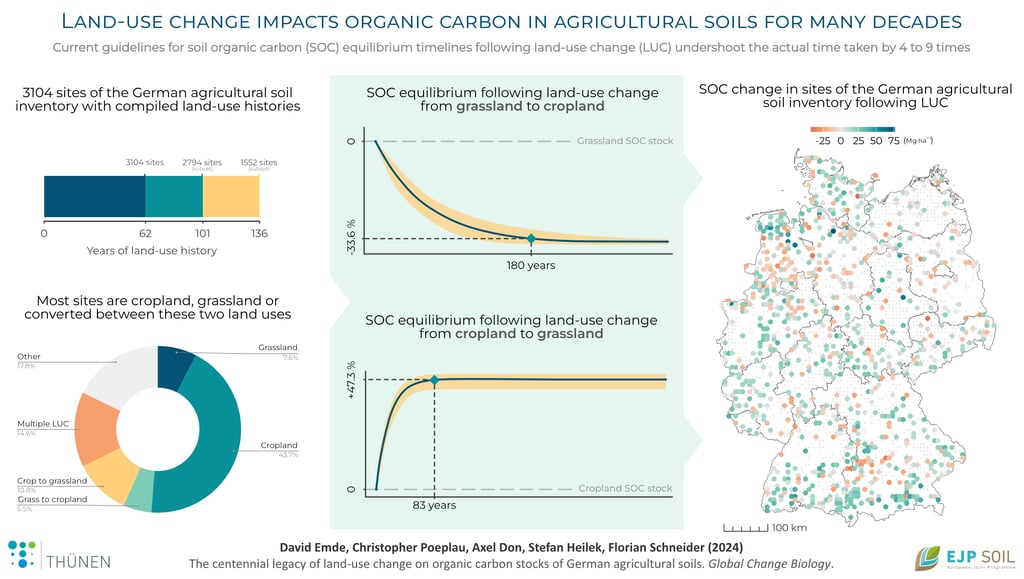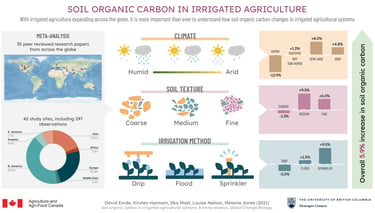PUBLICATIONS
Improved Broad-Scale Modelling of Soil Organic Carbon Dynamics Following Land-Use Changes
Daria Seitz, Rene Dechow, David Emde, Florian Schneider, Axel Don (2025)
Modelled soil organic carbon dynamics following conversion between grassland and cropland using a novel data-driven approach for model validation. Modelling developed a new, process-based model, RothC-LUC, that includes soil organic carbon stabilization in aggregate pools to better track SOC through time following land-use change.
Carbon sequestration in soils and climate change mitigation—Definitions and pitfalls
Axel Don, Felix Seidel, Jens Leifeld, Thomas Kätterer, Manuel Martin, Sylvain Pellerin, David Emde, Daria Seitz, Claire Chenu (2023)
This paper calls for the accurate use of terms surrounding the concept of carbon sequestration in soils, with examples, definitions, and potential pitfalls. The term "C sequestration in soils" is found to be used correctly only 4 % of the time in recent literature. Without accurate use of language regarding C accounting, the outcome of C enhancing measures may be misrepresented.
David Emde, Kirsten D. Hannam, Andrew J. Midwood, Melanie D. Jones (2022)
This paper estimates the mineral-associated organic carbon (MAOC) formation capacity and deficits of soils in the Okanagan Valley, British Columbia, Canada. We found that MAOC deficits were present in all soils and increased with depth, and that the upper 30 cm of these soils have the potential to increase MAOC stocks by 29% before they reach formation capacity.
The centennial legacy of land-use change on organic carbon stocks of German agricultural soils
David Emde, Christopher Poeplau, Axel Don, Stefan Heilek, Florian Schneider (2024)


This paper investigates how converting grasslands to croplands, or vice-versa, alters organic carbon in soils. We found that soils continue to experience changes to organic carbon stocks for many decades after conversion, and that a new equilibrium is reached at very different rates depending on the direction of land-use change.
David Emde, Kirsten D. Hannam, Ilka Most, Louise M. Nelson, Melanie D. Jones (2021)
A meta-analytical examination of the effect of agricultural irrigation (flood irrigation, sprinkler irrigation, and drip irrigation) in different climatic zones on soil organic carbon. This study found that there was an overall increase of SOC by 5.8% as a result of irrigation, though SOC change varied hugely between irrigation types and climate zones.


Andrew J. Midwood, Kirsten D. Hannam, Tirhas Gebretsadikan, David Emde, Melanie D. Jones (2021)
Several decades of woody perennial crop cultivation in the Okanagan Valley, British Columbia, Canada has substantially increased both particulate and mineral-associated organic carbon. This increase, however, is crop dependent. Carbon isotope analysis showed that carbon in perennial cropping systems is less microbially processed than their soil counterparts under natural vegetation.
Andrew J. Midwood, Kirsten D. Hannam, Thamas A. Forge, Denise Neilsen, David Emde, Melanie D. Jones (2020)
Crop and drive row carbon stocks were analysed under irrigated perennial woody crops in the Okanagan Valley, Canada. We found that soil carbon was spatially heterogeneous across all sites, with the surface soil of drive rows containing more carbon than crop rows, and that soils are responsive to changes in crop and associated management practices.


